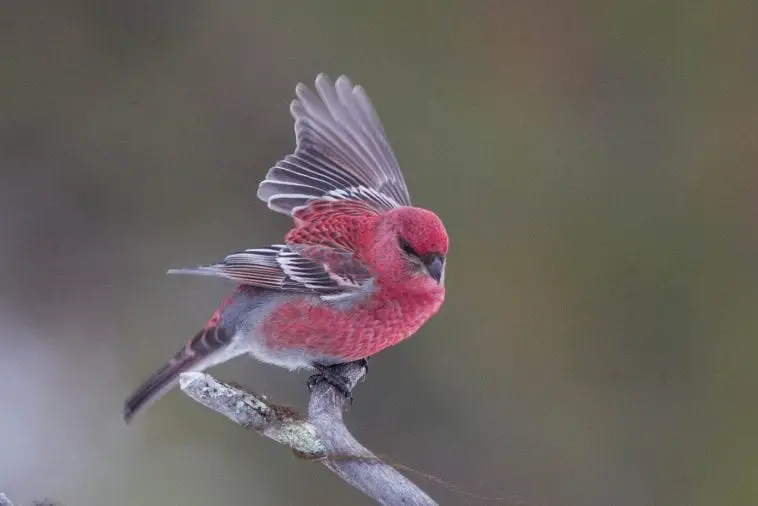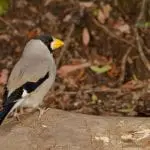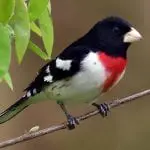Scientific Facts
| Common Name | Pine Grosbeak |
| Scientific Name | Pinicola enucleator |
| Lifespan | Over 9 Years |
| Size | 7.9 – 9.8 inches |
| Mass | 1.8 – 2.8 oz. |
| Habitat | Open woodlands |
| Range | North America (eastern Canada to western Alaska) Scandinavia to eastern Asia |
Information & Physical Appearance
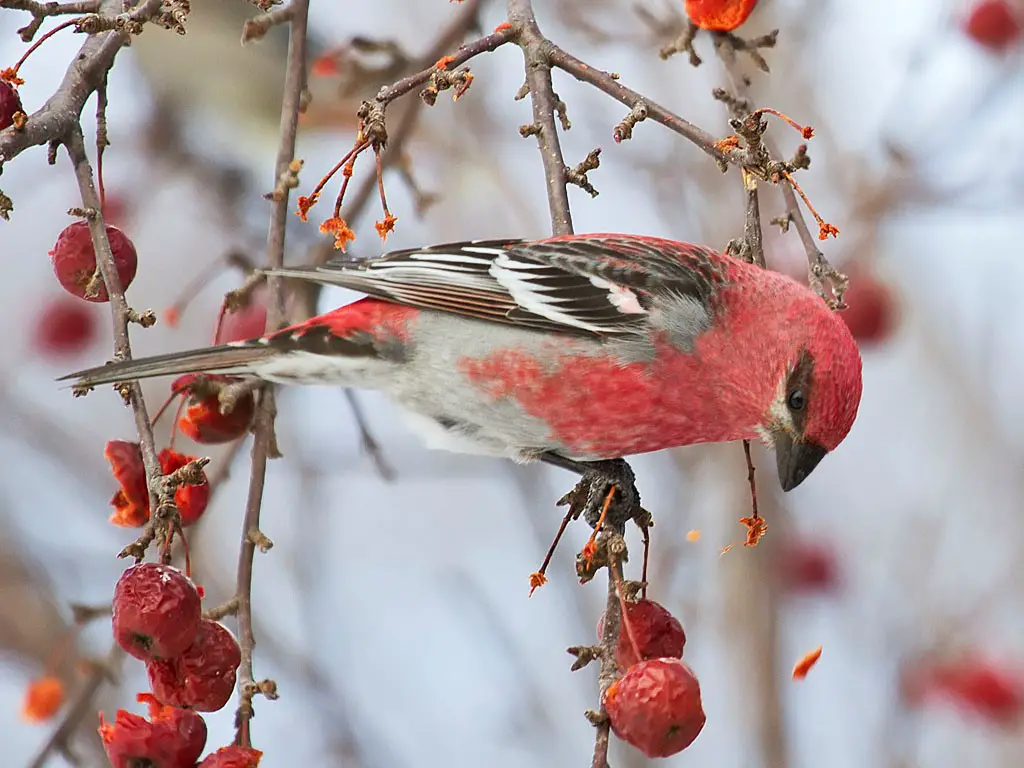
The Pine grosbeak, scientifically referred to as Pinicola enucleator, is part of the order Passeriformes, the family Fringillidae (the true finch family). This bird species is relatively large in size, especially as compared with other members of the family Fringillidae. In fact, the Pine grosbeak is one of the largest bird species in this family.
Other bird species in the true finch family include the Evening grosbeak, the Black rosy-finch, the Gray-crowned rosy-finch, the House finch, the Purple finch, the Brown-capped rosy-finch, the Cassin’s finch, the Hoary redpoll, the Common redpoll, the Cassia crossbill, the Red crossbill, the Pine siskin, the White-winged crossbill, the Lesser goldfinch.
The Pine grosbeak measures from 7.9 to 9.8 inches in length. More specifically, the tail is 3.1 to 3.7 inches in length, the tarsus is 0.75 to 0.91 inches in length, the bill is 0.55 to 0.65 inches in length, and the wing chord is 4.0 to 4.6 inches in length.
Pinicola enucleator weighs from 1.8 and up to 2.8 oz. The average body mass is estimated at 1.99 oz. The wingspan is 13 inches.
This bird species is plump, with a round head and a heavy chest.It is smaller than a Steller’s Jay and larger than a Cassin’s finch.
As compared to the bill of others, the Pine grosbeak’s bill is much stubbier. Also, the bill is conically shaped and rather thick. The black long tail is slightly forked.
Adult pine grosbeaks (males and females alike) are characterized by black wings and contrasting white wing bars.
The rump, back, as well as the head of the adult male pine grosbeak, are colored in rose-red.
The rump and the above part of the head of adult females display olive-yellow coloration. The underparts and the upper portion of the back are colored in grey.
Young pine grosbeaks differ from adult males as their plumage is less contrasting overall. It appears shaggy while the young ones are in the process of molting their colored head plumage.
Ultimately, while male pine grosbeaks are gray and reddish pink, females and juveniles are predominantly grayish in color, exhibiting tints of yellow or reddish-orange only on the rump and on the head.
The exact amount of reddish-pink tones on males’ bellies and on females’ head and rump is not set in stone, but instead, it is variable.
Lifespan
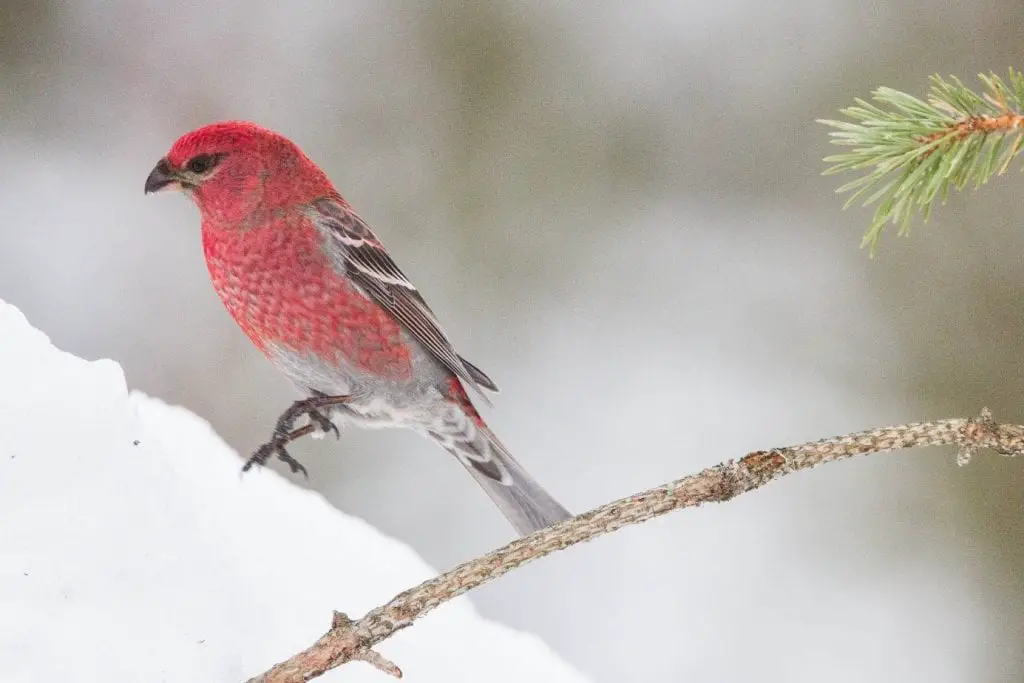
The oldest recorded Pine Grosbeak was at least 9 years and 9 months of age. The male specimen was found in 1970, in Quebec, Canada. It was back in 1961 when the individual was first captured and banded in Connecticut before being recaptured and rereleased into the wild almost 10 years later in Quebec.
Ecosystem & Habitat
The pine grosbeak is known as a permanent resident throughout most of its natural range. However, pine grosbeaks in the extreme north may migrate farther south when food is scarce. In fact, all pine grosbeaks may choose to migrate farther south when faced with scarce food resources, and not solely the ones found in the extreme north of their range.
When it comes to breeding, this bird species prefer the boreal forests of North America and northern Eurasia.
Breeding pine grosbeaks will either migrate to the boreal forests’ southern extent, traveling only relatively short distances or will choose to remain residents close to their breeding grounds instead.
It is during irruptive years when more pine grosbeaks will travel to southern boreal forests. Additionally, some may even move further south.
In irruptive years, this bird species can occur quite south of its usual winter range, in particular, northern New England in the U.S. and the northern parts of the Great Lakes region.
The pine grosbeak is considered a very rare vagrant in Europe’s temperate parts. More specifically, in Germany, not more than a total of four pine grosbeaks have been recorded to occur ever since 1980.
The Pine grosbeaks occur in the coniferous woods in Canada, the western mountains of the U.S., across Alaska, in Siberia, as well as in subarctic Fennoscandia.
Pinicola enucleator is an inhabitant of open pine, fir, and spruce forests. Also, it occurs in subalpine forests.
During the cold wintertime, this bird species may often prefer to use ash, maple, and mountain ash forests because of the greater abundance of seeds to feed with. However, in many cases, pine grosbeaks tend to stay in similar habitat during the winter, by simply moving to lower elevations to stay away from extreme cold.
In the Sierra Nevada, Pine grosbeaks are known to occur in open lodgepole pine and red fir forests located at elevations higher than 6000 feet.
In the Rocky Mountains, Pine grosbeaks are known to most commonly occur at elevations above 9000 feet, in particular, in valleys situated near timberline.
Food & Diet
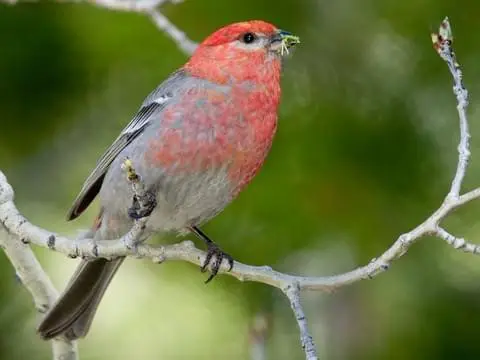
Pine grosbeaks thrive on a primarily vegetarian diet. Almost as much as 100% of their diet consists of various fruits, seeds, and buds obtained from pine, mountain ash, spruce, box elder, birch, crabapple, burdock, ragweed, maple, and juniper.
These birds feed by foraging on the ground. Nonetheless, they also forage in trees, either directly grabbing their favorite fruits and seeds, or simply nipping needles or fresh buds from the very tips of the branches.
Despite being almost entirely vegetarian, Pine grosbeaks will occasionally catch spiders and insects in the summer season. Live prey is especially rich in protein, which is much-needed to support the healthy, proper growth of Pine grosbeaks’ young chicks. Apart from feeding insects and spiders to their young, they also provide mixed plant foods along.
Interestingly, pine grosbeaks are known to drink water and/or eat snow on a daily basis all year-round. In the wintertime, they do also eat salt and grit along roadsides. The species is especially frugivorous during the winter when various small fruits, such as mountain ash fruits, are strongly favored.
Pine grosbeaks will gladly visit bird feeders filled with suet or black oil sunflower seeds.
Behavior
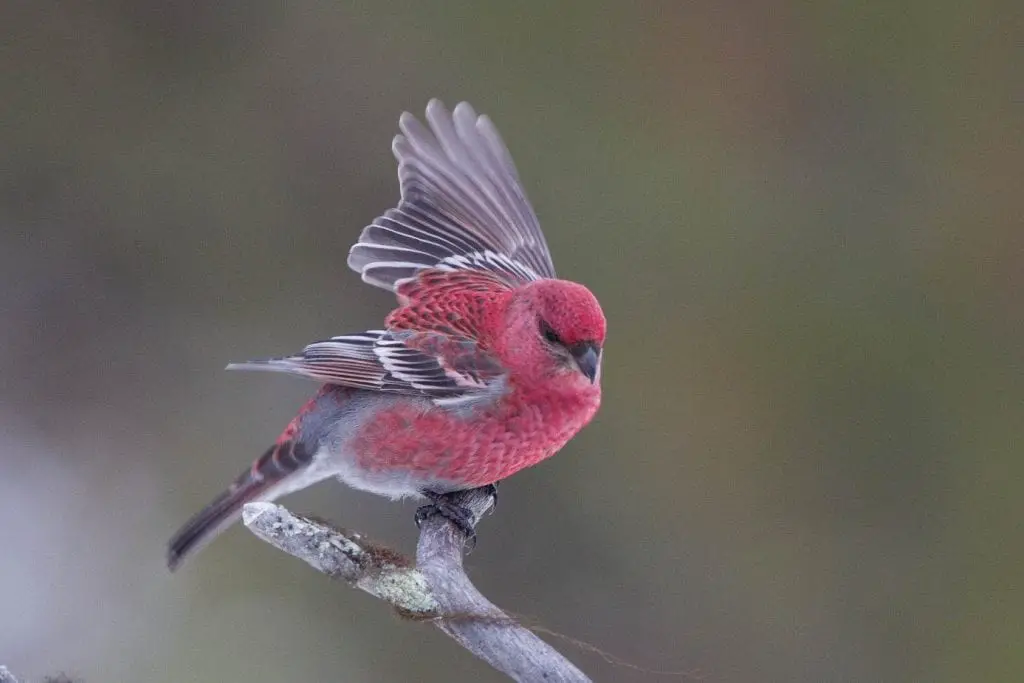
Pine grosbeaks are known to exhibit irruptive behavior. Irruptive behavior is actually typical for many other bird species that reside in the subarctic. The irruptive behavior is closely related to the variable abundance of fruit crops from one year to another.
During the irruption years, pine grosbeaks can travel long distances in order to find the much-needed food supplies they require in order to survive. Some individuals may be brought much farther south than the usual range; they can be found within years with large fruit crops available.
Pine grosbeaks will often manage to raise more young chicks, with the young being more likely to survive the winter when boreal tree species happen to produce large seed crops in particular years.
However, in years when the boreal tree species fail to produce large seed crops, the already larger population of pine grosbeaks that occurred during the years of abundant seed crops will irrupt outside of their normal breeding range, searching for food.
Sluggishly hopping among branches, pine grosbeaks nip off fresh needles and/or buds. Foraging on the ground by either walking or hopping, these birds grab readily fallen seeds.
During the breeding season, adult males are known for singing their warbling songs from the top of selected trees.
It is during the winter when these birds are to form small groups, consisting of 5 and up to 15 members. These small groups will t travel together, searching for fruits and seeds. It is these winter groups of pine grosbeaks that may also frequently show up at bird feeders.
This bird species do not forage with other groups that possess different flight calls.
Pine grosbeak individuals with the same song type are known to stick together in areas where different call types co-exist.
Monogamous pairs are formed during the breeding season. To defend their breeding territory, males are to sing from treetops.
It is believed that mated pairs may form very strong bonds with each other, as the female and the male mate within the breeding pair have been discovered to have identical flight calls.
Reproduction
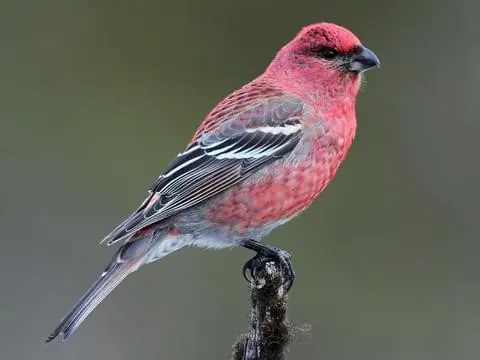
The pine grosbeak’s breeding habitat is open coniferous forests consisting of fir, spruce, and pine trees. The nest is built between 6 and up to 16 feet above the ground, either in a fork of a conifer tree or on a horizontal branch.
Nesting in evergreen trees, this bird species’ nest is well-camouflaged thanks to dense vegetation.
The building of the nest is the responsibility of the female. First, the female is to weave small twigs and roots to create the outer cup. Next, she is to construct the inner cup using twigs, grass, and rootlets, lined with evergreen needles, feathers, lichen, and soft grasses.
The nest measures about 6–9 inches across. It is 3–4 inches deep on the outside. The inner cup is about 2.5 – 3.0 inches across.
Between 3 and 4, pale blue eggs with darker markings and dots are laid. The egg’s length is around 1 inch, and the width is about 0.7 inches.
The incubation period lasts for 13 and up to 14 days, while the nestling period takes 13 and up to 20 days.
At hatching, the young chicks are helpless and naked. They only have a few downy feathers on the back and on the head.
Health Risks, Survival Threats & Conservation
Possible Health Issues
1. It was just recently in 2018 when pine grosbeaks captured at banding stations in Alberta and Saskatchewan, Canada, have been reported to exhibit a clinical presentation that was found to be consistent with the clinical presentation of the scaly-leg disease.
Interestingly, there were no previous recorded instances of pine grosbeaks suffering from the scaly-leg disease in the existing literature. Up-to-date, the very cause of the presentation of this disease in pine grosbeaks remains unclear.
However, a similar clinical presentation has been previously diagnosed in other species of wild passerine birds, such as robins, evening grosbeaks, cowbirds, house sparrows, red-winged blackbirds, grackles, and house wrens, among others. With these wild passerine species, the disease was associated with a parasitic mites’ infestation.
Parasitic mites are known to burrow into the top layer of the skin around the eyelids, legs, beak, vent, and/or feet, where no feathers are present, and the mites feed on keratin.
When feeding, these mites create tunnels through the top layer of the skin (aka the epithelium), and as they proceed, they damage the tissues. As a result, irritation occurs. Also, the infected area becomes swollen and further develops a scaly, crusty discolored appearance.
When this disease is to occur on the birds’ legs, it is commonly referred to as scaly-leg. Most commonly, infection appears in older birds.
In the case of chronic inflammation, the infected birds may become lame, with possible deformations occurring on parts of the legs or the feet. Potentially, the infection can lead to the death of the sick birds.
Infected birds may also display an inability to perch.
2. One of the most common sources of mortality among pine grosbeaks is the frequent collisions with moving cars in the winter when the birds are especially attracted to sand and salt found on the roads.
3. Mycoplasmosis in pine grosbeaks and evening grosbeaks with conjunctivitis was also discovered in Quebec, Canada.
During the winter of 1998 – 1999, a conjunctivitis outbreak affected pine and evening grosbeaks in Quebec.
At least 1% and up to 30% of the affected individuals were found sick at 13 bird feeding stations. The sick birds were described as rather thin, with conjunctivitis and rhinitis. By means of direct immunofluorescence, Mycoplasmal organisms, and in particular, Mycoplasma gallisepticum, were identified.
4. Up-to-date, explicit information regarding the most common diseases that may affect wild Pine grosbeaks remains rather scarce. In captivity settings, Pine grosbeaks were found to be especially prone to respiratory issues.
Survival Threats and Conservation
1. Pine grosbeaks are considered fairly uncommon in the U.S. That’s because this bird species breeds in rather small forest pockets located in the western mountains. Because of this, pine grosbeaks are quite easy to overlook.
Furthermore, much of the pine grosbeaks’ breeding range in the far north actually lies outside of the North American Breeding Bird Survey area. Thus, estimating the population trends precisely remains a very difficult task to accomplish.
2. According to the data provided by the North American Breeding Bird Survey, between 1966 and 2015, the pine grosbeaks’ population has suffered a consistent decline by 2.4% per year. Ultimately, the gradual decline has resulted in a cumulative decline of 70%.
3. According to the information shared by Partners in Flight, the global breeding population of pine grosbeaks is estimated at 8.9 million birds. 34% of the pine grosbeaks spend some part of their time in Canada, while 18% spend some part of their time in the United States.
4. Pinicola enucleator is NOT on the 2016 State of North America’s Birds’ Watch List.
5. On the Continental Score, the pine grosbeak rates 10 out of 20.
6. At least in California, pine grosbeaks have been estimated as vulnerable to climate change, based on research modeling the projected impact of the ongoing climate crisis, characterized by a consistent, gradual rise in temperatures and the growing threats related to wildfires, earthquakes, drought, floods, etc.
7. The Pine Grosbeak is listed as Least Concern on the IUCN Red List of Threatened Species. The population trend is decreasing. On the bright side, the birds appear in at least one protected area and are part of a systematic monitoring scheme. The population is not severely fragmented. One of the threats to the survival of this bird species is the international use and trade of the pine grosbeak as pets/display animals.
Availability – Where to Get a Pine Grosbeak
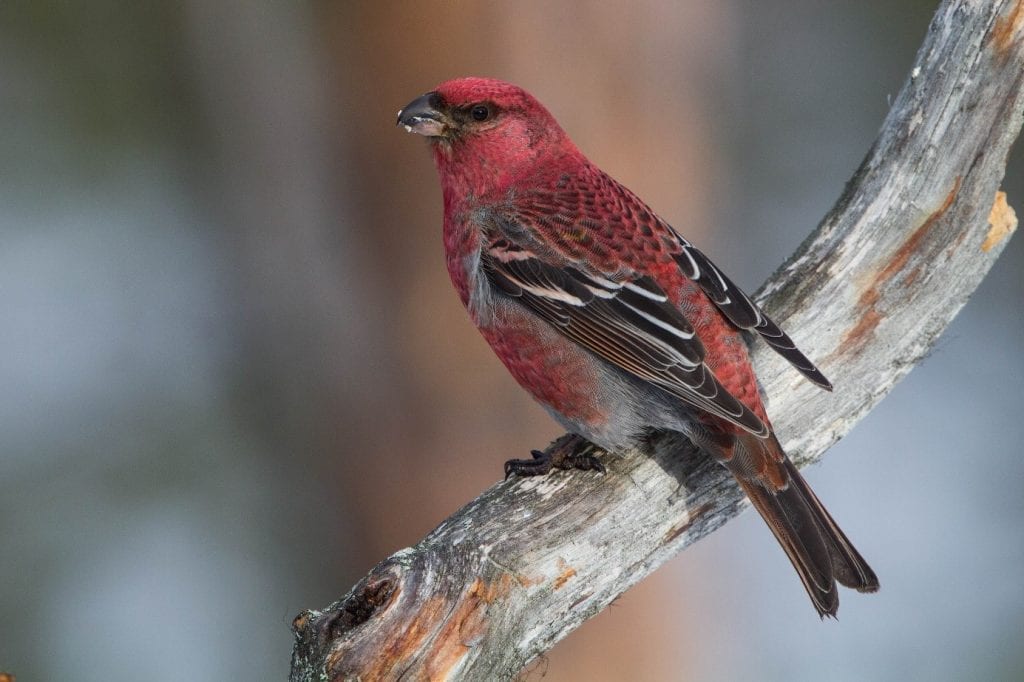
The pine grosbeak is not a caged bird. Although raised in captivity for research purposes, it should not be kept as a pet, since it is a wild creature. Thus, you cannot get a pine grosbeak in the same sense you can get a parrot.
Fortunately, for the passionate birders, it is fully possible to contemplate pine grosbeaks in the wild in their natural habitat.
As a rule of thumb, there are two ways to come across Pine grosbeaks.
1. Look for Pine grosbeaks across their breeding grounds in Canada or in the West.
2. In the wintertime, attract Pine grosbeaks to your backyard/garden in the northern states using sunflower seed feeders, and simply wait for the feathery fellows to come to you!
During the summer season, bird watch enthusiasts should look for pine grosbeaks in open pine and spruce forests. It is a great idea to listen to their warbling, rich, short songs. Males are to sing from the treetops from the middle of May until the beginning of August.
Mind that the voice of this bird species is geographically variable. It includes a whistled “chii-vli” note or a whistled triple “pui” note.
It is fairly easy to get a glimpse of the pine grosbeak, as compared with being lucky enough to spot any other finch, since pine grosbeaks are rather large in size, and they are also behaving quite sluggishly.
Pine grosbeaks are frequent visitors at bird feeders. Nonetheless, it is also fully possible to find a small group of foraging grosbeaks engaged in eating salt and grit along roadsides located near evergreen forests.
Interesting Facts
1. The pine grosbeak’s scientific name (Pinicola enucleator) has a Latin origin. The name of the genus “Pinicola” is derived from the word “pinus,” translating as “pine tree.” The word “colere” means “to dwell,” and more specifically, the word “enucleator” is derived from “enucleare,” which means “to remove the kernel.”
2. The pine grosbeak and the crimson-browned finch are relatives. They represent an ancient divergence of the very same stock. It is this stock that is known to have given rise to Pyrrhula, the true bullfinches.
It is suggested that the Pinicola lineage had finally diverged from its relatives some 12 million years ago, and in particular, during the mid-Miocene’s Clarendonian faunal stage.
Nine subspecies have been described across the pine grosbeaks’ range. Five of these species represent the New World forms and are known to show differences in their vocalizations and plumage. These differences suggest that there is a genetic divergence, most probably to species level, within the New World.
Meanwhile, the Pyrrhula’s evolutionary radiation throughout Eurasia, as well as the Holarctic expansion of the Leucosticte mountain finches and their relatives, began at the same time.
These particular genera evolved in Asia’s interior. Therefore, the original Pinicola stock was most probably already an existing conifer forest birds occupying the north parts of the Himalayas.
According to some researchers, it is highly likely that the separation of the modern-day Pinicola species has resulted because of climate change.
Climate change is suggested to have played a huge role in displacing the former Pinicola habitat to subalpine Himalayan regions and subarctic northern regions.
Furthermore, it is considered quite possible that the North American pine grosbeaks’ ancestors were wind-blown individuals who got to arrive through the northern Pacific.
3. Even though adult pine grosbeaks do eat a considerable amount of plants, it tends to be tough for the young chicks to successfully eat and digest vegetation. And so, adults are to regurgitate a paste of insects, as well as a vegetable matter to feed their nestlings, instead of directly feeding plant material. The regurgitated paste is stored in the pouches located at the lower part of the birds’ jaws.
4. Winter flocks of pine grosbeaks have been observed to stay near a tree where abundant fruit is available up until the very point when all of the fruit is thoroughly consumed.
5. Pine grosbeaks can greatly differ in the intensity of red and the amount of red they display, as well as their size. Indeed, not all pine grosbeaks across their common range are the same!
From Newfoundland to the Yukon Territory, the pine grosbeaks’ wing length, tail length, and overall body size are generally found to increase.
In Queen Charlotte Island, as well as in California, the smallest of all pine grosbeaks can be observed. As compared with the length of the wings and tails of pine grosbeaks found in Alaska, the wings and tails lengths of the pine grosbeaks on Queen Charlotte Island are about ½ inch smaller.
7. In Newfoundland, the locals affectionately call the Pine grosbeak a “mope” because of this bird species’ slow-moving behavior and sweet tameness.
8. Plumage coloration also varies across the range of the pine grosbeak. However, plumage coloration differences are not consistent. Pine grosbeaks in the West are often found to have less red. Female pine grosbeaks in California tend to have more yellowish, while males tend to have more orangeish.
How to Care for the Pine Grosbeak
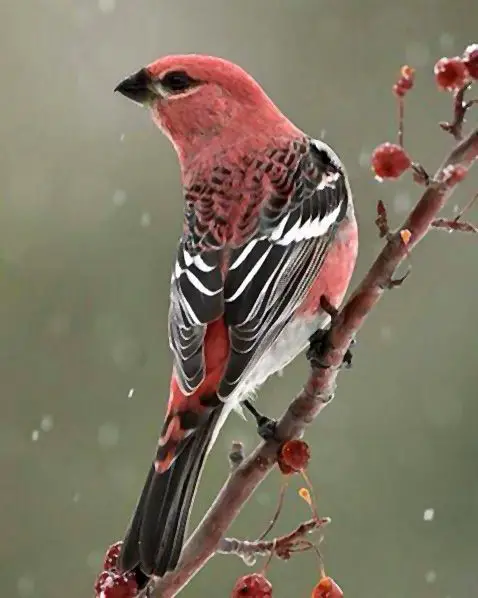
1. To take good care of the Pine Grosbeaks, those who happen to reside in these birds’ range can provide feeders filled with suitable seeds to offer a much-needed source of food during the winter when food availability is rather scarce.
2. Pine grosbeaks will benefit from platform feeders, large tube feeders, or large hopper feeders loaded with high-quality black oil sunflower seeds, suet, or hulled sunflower seeds. Additionally, fruits are greatly favored by pine grosbeaks.
3. Do note that when making use of bird feeders, it is imperative to help prevent the possible spread of disease. The birds that come to feed at the bird feeder should be monitored for signs of illness. The bird feeders and birdbaths alike should be thoroughly and properly cleaned on a regular basis.
For best results, use a 10% bleach (9 parts warm water, 1 part bleach) solution for cleaning purposes twice a month. On a weekly/daily basis, as needed, use hot, soapy water.
4. Only provide fresh, top-grade seeds, as moldy seeds can cause serious illness in birds. Store seeds the right way to prevent deterioration.
5. In the case you encounter any incidents of sick or dead birds, immediately contact professionals to help you identify the disease or possible outbreak without exposing your own health, as well as the health of other people, to unwanted risks.
6. Since the ongoing consequence of climate change are suggested to possibly contribute to the further decrease in the population of pine grosbeaks, embracing environmental-friendly practices and spreading awareness over the dire need to protect wildlife biodiversity, as well as the importance of limiting our negative carbon footprint on the living nature, can greatly assist in taking best care for the pine grosbeak
FAQs
What Does a Pine Grosbeak Look like?
The Pine Grosbeak is a large-sized, plump finch, with a thick, conical bill, and a long, slightly notched tail. Males are gray and reddish pink, while females are mostly grayish in color, with only limited splashes of yellow or orangeish red on the rump and on the head.
How Do You Attract Pine Grosbeaks?
To attract pine grosbeaks, birders can make use of a hopper style seed feeder filled with fresh, quality black oil sunflower seeds, as these are among the pine grosbeaks’ most favorite winter treats. Considering the relatively large size of this bird species, the bird feeder should ideally offer proper perching space.
Do Pine Grosbeaks Migrate?
The pine grosbeak is described as is a permanent resident through most of its natural range. However, when the food sources happen to become more scarce than usual in the winter, pine grosbeaks may migrate farther south.
Are Pine Grosbeaks Finches?
Yes, pine grosbeaks are finches, as they belong to the family Fringillidae, the true finch family. The very word “grosbeak” was first applied back in the 1670s, and is derived from the French word “grosbec,” with “gros” meaning “large,” and “bec” meaning “beak.”
What Does a Pine Grosbeak Sound like?
Male pine grosbeaks, and only very occasionally female pine grosbeaks, will sing from the treetops, the song reminding of a flutelike warble. The pine grosbeaks’ song is quite similar to that of purple finches; however, with pine grosbeaks, the song sounds less harsh and much richer and is also slower.
What Do Pine Grosbeaks Eat in Winter?
In the winter, pine grosbeaks mainly feed on vegetable matter, including the seeds of various trees, grasses, and weeds, as well as any fruits possibly available. In the wintertime, pine grosbeaks will readily come to bird feeders loaded with black sunflower seeds or suet.
Where Do Pine Grosbeaks Breed?
Pine grosbeaks breed in Mongolia, Kazakhstan, the United States, the Russian Federation (Eastern Asia Russia), and in Norway.
How Big is a Pine Grosbeak?
The Pine grosbeak is one of the largest members of the true finch family. The Pine grosbeak measures between 7.8 – 9.8 inches in length, and weighs from 1.8 to 2.8 oz.
Are Pine Grosbeaks Aggressive?
No, the pine grosbeak is not an aggressive bird species in general. Evening grosbeaks are known to become aggressive at times, yet the pine grosbeak is renowned for its tameness, accompanied by adorably sluggish behavior.
Is the Pine Grosbeak Endangered?
The pine grosbeak is not considered critically endangered, but it is listed as Least Concern on the IUCN Red List of Threatened Species. The population trend is decreasing, based on the last global assessment.

